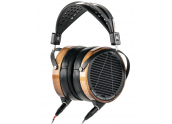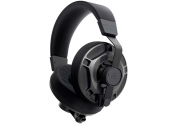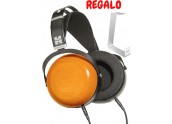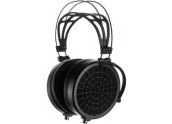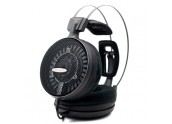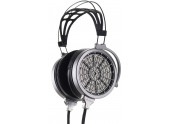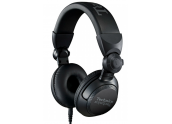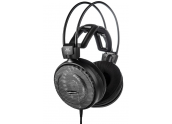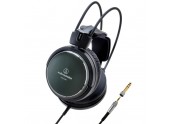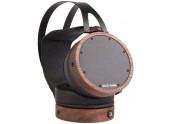Sennheiser HD215
Oferta de segunda mano en perfecto estado - oportunidad
Sennheiser HD215 --VENDIDO-- Oferta segunda mano - oportunidad - Auriculares cerrados serie DJ/Studio. -
General Description
Enjoy excellent sound: The HD 215 has both outstanding sound characteristics and excellent attenuation of ambient noise. The rotatable ear cup for one-ear listening and the single-sided coiled cable make them ideal for DJ monitoring. The HD 215 comes with a convenient protective pouch for storage and transportation.
Features
Excellent stereo sound
Spatial sound image
Outstanding wearing comfort for long listening sessions
Excellent attenuation of ambient noise
Ear cup is rotatable for one-ear listening
Convenient protective pouch included
Extremely rugged
Single-sided coiled cable, detachable
Comfortable headband and ear pads
1 ⁄4" (6.3 mm) screw-on jack adaptor, gold-plated (Foto)
2-year warranty
Delivery Includes
Headphone with single-sided coiled cable, detachable
6,3 mm adaptor
Convenient protective pouch
Technical Data
Jack plug 3,5/6,3 mm stereo
Nominal impedance 32 ¥Ø
Weight w/o cable ca. 280 g
Transducer principle dynamic, closed
Ear coupling circum-aural
Cable length 3 m
Frequency response (headphones) 12.....22000 Hz
Sound pressure level (SPL) 112 dB(SPL)
THD, total harmonic distortion <0,2 %
Glossary
Jack plug
A common audio connector in consumer electronics and music industry. Available in various diameters; in the hi-fi segment, 1/8¡± and ¨ù¡± are widely used. Poles range from one to four. (Examples: headphone jack or jack of an electric guitar).
Nominal impedance
See impedance.
Weight w/o cable
Transducer principle
Two transducer principles have become established for the conversion of electric energy into mechanical energy: electrodynamic and electrostatic transducers, whereby the latter is only to be found in audiophile systems, due to their relatively high manufacturing costs. Electrodynamic transducers basically consist of a ring-shaped permanent magnet and an oscillation coil, which is fixed to the receiver diaphragm. When an audio-frequency alternating current is passed through the oscillation coil, it is caused to vibrate in accordance with the audio-frequency alternating current, thus causing the diaphragm to vibrate in the same way.
Ear coupling
A distinction is made between headphones which are worn on the external ear (supra-aural) and those which surround the ear (circumaural). Open headphones have foam ear pads that rest on the ears or ring pads that surround the ears. Closed headphones, on the other hand, nearly always have circumaural ear pads.
Cable length
The cable length is usually measured between the anti-kink sleeves of the cable (cable length without connectors).
Frequency response (headphones)
The frequency response of a pair of headphones is given within limits defined by the manufacturer.
Sound pressure level (SPL)
Due to the impractical numerical values, the sound pressure is usually given as the logarithmic value of the sound pressure level according to the equation: dB SPL = 20 x log (po / 0.00002 Pa). The abbreviation SPL (sound pressure level) is added in order to make a clear distinction from other uses of dB. The reference sound pressure, which is at the same time the threshold of hearing, is then 0 dB SPL. The threshold of pain is 140 dB SPL. A difference in the sound pressure level of 1 dB is just about perceptible, while a doubling of the sound pressure corresponds to 6 dB and a doubling of the volume corresponds to a rise of 10 dB.
THD, total harmonic distortion
Total harmonic distortion is a measure of non-linear harmonic distortion and is given in %. Non-linear harmonic distortions are signals which were not present in the original before the signal was converted by the headphones. These unwanted signals are caused by the diaphragm, whose movements do not precisely move in time with the electric signals that cause it to move. Unfortunately, this is a feature of all electroacoustic transducers. Although it cannot be completely eliminated, suitable steps can be taken to minimise it. However, the user is not interested in why this distortion takes place but in how great the level of distortion must be for it to become perceptible. According to the findings of several research projects, a total harmonic distortion of 1% in the frequency range of 100 to 2000 Hz is imperceptible. Below 100 Hz, the perceptibility threshold lies at 10%.
16 productos de la misma categoría:
-
Denon AH-D9200
AHD9200 - Modelo TOP de la marca Denon, utiliza unos nuevos drivers, copas realizada...
1.699 € -12% 1.495 € -
Audeze LCD2
Audeze LCD2 Auriculares tipo Circumaural abierto | Tecnología Plano Magnética | Impe...
1.199 € -
Final Audio D7000
Final Audio D7000 auriculares de referencia con transductores magnéticos planos | Dr...
3.499 € -
Hifiman Sundara Closed
Hifiman Sundara Closed Black - Versión con las copas de diseño cerrado y realizadas ...
479 € 169 € -
Dan Clark Audio ETHER 2
ETHER 2 - Nueva generación de auriculares planar magnéticos. Peso de 290 gramos (90 ...
2.759 € -
Audio Technica ATH-AD2000X
ATH- AD2000X Auriculares Hi-Fi abiertos | Compatible con audio en alta resolución | ...
999 € -
Dan Clark Audio VOCE
Voce Auriculares Electrostáticos | Transductores electrostáticos circulares exclusiv...
3.999 € 2.999 € -
Sivga Audio Luan
Sivga Audio Luan - Auriculares con diseño abierto | Drivers de 50mm | Supra-aurales ...
349 € -
Technics EAH-DJ1200
Technics EAH-DJ1200 Auriculares DJ | Altavoz de 40mm y sonido balanceado desde baja ...
179 € 157 € -
Audio Technica ATH-AD700X
ATH-AD700X Auriculares de Alta Fidelidad abiertos | Transductores de 53mm | Carcasa ...
200 € -
FiiO JT1
FiiO Jade JT1 -- Auricular abierto de diadema | transductor dinámico de 50 mm | 32 O...
75 € -
Hifiman Sundara
HIFIMAN SUNDARA - Auriculares con diseño planar-magnético y abierto. Respuesta de fr...
349 € 299 € -
Hifiman Deva Wired
Hifiman Deva Wired | Auricular con Diseño Abierto | Versión con cable del modelo
220 € 139 € -
Audio Technica ATH-A990Z
ATH-A990Z Auriculares dinámicos cerrados Art Monitor | Altavoz de 53mm | Sistema D.A...
260 € -
Sennheiser HD 206
Sennheiser HD 206 Auriculares con diseño cerrado | Longitud del cable 3m | Acabado e...
35 € 25 € -
Ollo Audio S4R
Ollo Audio S4R Auricular con diseño Cerrado | Aislamiento acústico | Transductor de ...
419 €














